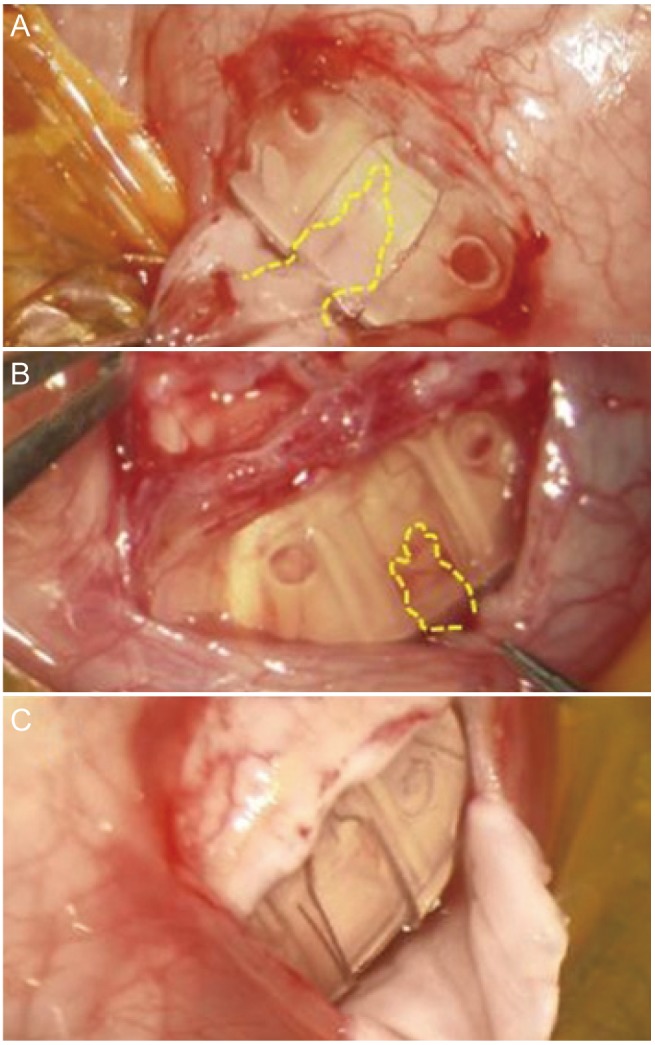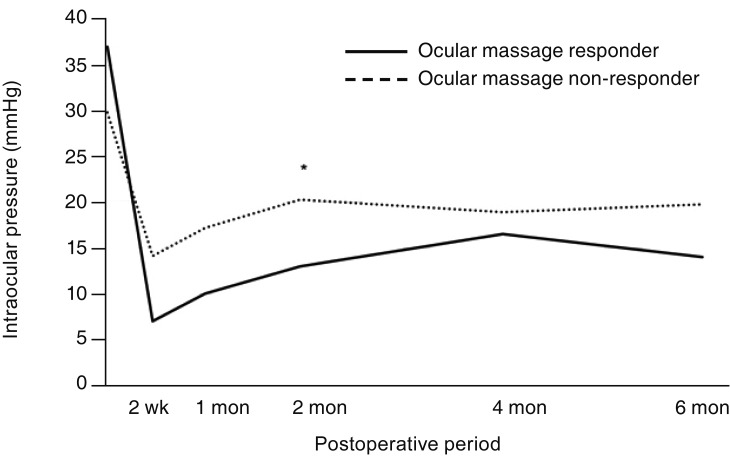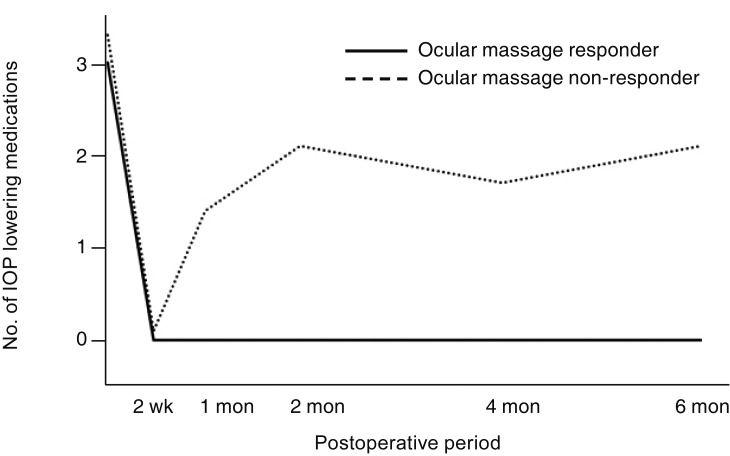Korean J Ophthalmol.
2019 Jun;33(3):214-221. 10.3341/kjo.2018.0110.
Encapsulated Bleb Excision with Collagen Matrix Implantation Following Failed Ahmed Glaucoma Valve Implantation
- Affiliations
-
- 1Department of Ophthalmology, Chungnam National University College of Medicine, Daejeon, Korea. kknace@cnuh.co.kr
- KMID: 2448860
- DOI: http://doi.org/10.3341/kjo.2018.0110
Abstract
- PURPOSE
To investigate the clinical features and surgical outcomes of encapsulated bleb excision with collagen matrix implantation performed in patients with failed Ahmed glaucoma valve (AGV) implantation.
METHODS
Eighteen eyes of 18 patients underwent encapsulated bleb excision and collagen matrix implantation. Patients were divided into two groups by reference to intraocular pressure (IOP) after preoperative ocular massage: group 1, patients who exhibited substantial IOP reductions; and group 2, patients who did not show substantial changes in IOP. Needling was conducted in group 2. The clinical features of the two groups were compared, including IOP changes after ocular massage and needling, AGV status, and surgical outcomes 6 months after surgery.
RESULTS
The mean preoperative IOP among the 18 patients was 30.6 ± 5.7 mmHg. After ocular massage, the IOPs decreased by 22 and 26 mmHg in the two patients in group 1 and the 16 patients in group 2 showed a mean IOP reduction of 1.6 ± 2.2 mmHg (p = 0.013). IOPs decreased after needling in group 2 (range, 6 to 30 mmHg; p < 0.001). Fibrovascular tissue ingrowth into the AGV was observed in the two patients in group 1 and the same ingrowth was observed in 10 of the 16 patients in group 2. Six months after surgery the mean IOP among the 18 patients decreased significantly (19.1 ± 3.2 mmHg, p < 0.001). There was no significant difference in the mean postoperative IOP at 6 months between group 1 (14.0 ± 2.8 mmHg) and group 2 (19.8 ± 2.6 mmHg, p = 0.052).
CONCLUSIONS
Encapsulated bleb excision with collagen matrix implantation resulted in a significant IOP-lowering effect 6 months after surgery. Fibrovascular ingrowth into the AGV was common but did not seem to be a major cause of AGV implantation failure.
Figure
Reference
-
1. Quigley HA, Broman AT. The number of people with glaucoma worldwide in 2010 and 2020. Br J Ophthalmol. 2006; 90:262–267. PMID: 16488940.
Article2. Rosentreter A, Mellein AC, Konen WW, Dietlein TS. Capsule excision and Ologen implantation for revision after glaucoma drainage device surgery. Graefes Arch Clin Exp Ophthalmol. 2010; 248:1319–1324. PMID: 20405139.
Article3. Lai JS, Poon AS, Chua JK, et al. Efficacy and safety of the Ahmed glaucoma valve implant in Chinese eyes with complicated glaucoma. Br J Ophthalmol. 2000; 84:718–721. PMID: 10873981.
Article4. Coleman AL, Smyth RJ, Wilson MR, Tam M. Initial clinical experience with the Ahmed glaucoma valve implant in pediatric patients. Arch Ophthalmol. 1997; 115:186–191. PMID: 9046253.
Article5. Yang HK, Park KH. Clinical outcomes after Ahmed valve implantation in refractory paediatric glaucoma. Eye (Lond). 2009; 23:1427–1435. PMID: 18756285.
Article6. Goulet RJ 3rd, Phan AD, Cantor LB, WuDunn D. Efficacy of the Ahmed S2 glaucoma valve compared with the Baerveldt 250-mm2 glaucoma implant. Ophthalmology. 2008; 115:1141–1147. PMID: 18164068.
Article7. Kim MS, Kim KN, Kim CS. Changes in corneal endothelial cell after Ahmed glaucoma valve implantation and trabeculectomy: 1-year follow-up. Korean J Ophthalmol. 2016; 30:416–425. PMID: 27980360.
Article8. Gedde SJ, Schiffman JC, Feuer WJ, et al. Treatment outcomes in the Tube Versus Trabeculectomy (TVT) study after five years of follow-up. Am J Ophthalmol. 2012; 153:789–803. PMID: 22245458.
Article9. Joshi AB, Parrish RK 2nd, Feuer WF. 2002 Survey of the American Glaucoma Society: practice preferences for glaucoma surgery and antifibrotic use. J Glaucoma. 2005; 14:172–174. PMID: 15741822.10. Desai MA, Gedde SJ, Feuer WJ, et al. Practice preferences for glaucoma surgery: a survey of the American Glaucoma Society in 2008. Ophthalmic Surg Lasers Imaging. 2011; 42:202–208. PMID: 21563745.
Article11. Chen PP, Palmberg PF. Needling revision of glaucoma drainage device filtering blebs. Ophthalmology. 1997; 104:1004–1010. PMID: 9186442.
Article12. Jung KI, Park H, Jung Y, Park CK. Serial changes in the bleb wall after glaucoma drainage implant surgery: characteristics during the hypertensive phase. Acta Ophthalmol. 2015; 93:e248–e253. PMID: 25363490.
Article13. Topouzis F, Coleman AL, Choplin N, et al. Follow-up of the original cohort with the Ahmed glaucoma valve implant. Am J Ophthalmol. 1999; 128:198–204. PMID: 10458176.14. Huang MC, Netland PA, Coleman AL, et al. Intermediate-term clinical experience with the Ahmed Glaucoma Valve implant. Am J Ophthalmol. 1999; 127:27–33. PMID: 9932995.15. Ayyala RS, Pieroth L, Vinals AF, et al. Comparison of mitomycin C trabeculectomy, glaucoma drainage device implantation, and laser neodymium:YAG cyclophotocoagulation in the management of intractable glaucoma after penetrating keratoplasty. Ophthalmology. 1998; 105:1550–1556. PMID: 9709773.16. Quaranta L, Floriani I, Hollander L, et al. Needle revision with 5-fluorouracil for the treatment of Ahmed glaucoma valve filtering blebs: 5-fluoruracil Needling revision can be a useful and safe tool in the management of failing Ahmed glaucoma valve filtering blebs. J Glaucoma. 2016; 25:e367–e371. PMID: 26766399.17. Shah AA, WuDunn D, Cantor LB. Shunt revision versus additional tube shunt implantation after failed tube shunt surgery in ref ractory glaucoma. Am J Ophthalmol. 2000; 129:455–460. PMID: 10764852.18. Al-Mosallamy SM. Decapsulation versus valve reimplantation in cases with an encysted Ahmed valve in refractory glaucoma. Delta J Ophthalmol. 2015; 16:22–26.
Article19. Kim JR, Lee JM, Kee CW. Tissue incarceration after Ahmed valve implantation. J Korean Ophthalmol Soc. 2012; 53:1053–1056.
Article20. Wilson RP, Cantor L, Katz LJ, et al. Aqueous shunts. Molteno versus Schocket. Ophthalmology. 1992; 99:672–676. PMID: 1594210.21. Siegner SW, Netland PA, Urban RC Jr, et al. Clinical experience with the Baerveldt glaucoma drainage implant. Ophthalmology. 1995; 102:1298–1307. PMID: 9097766.
Article22. Hong CH, Arosemena A, Zurakowski D, Ayyala RS. Glaucoma drainage devices: a systematic literature review and current controversies. Surv Ophthalmol. 2005; 50:48–60. PMID: 15621077.
Article23. Ishida K, Netland PA. Ahmed Glaucoma Valve implantation in African American and white patients. Arch Ophthalmol. 2006; 124:800–806. PMID: 16769833.
Article24. Song M, Lee S, Choe D, et al. Clinical and biological evaluations of biodegradable collagen matrices for glaucoma drainage device implantation. Invest Ophthalmol Vis Sci. 2017; 58:5329–5335. PMID: 29049735.
Article25. Trigler L, Proia AD, Freedman SF. Fibrovascular ingrowth as a cause of Ahmed glaucoma valve failure in children. Am J Ophthalmol. 2006; 141:388–389. PMID: 16458704.
Article26. Hill RA, Pirouzian A, Liaw L. Pathophysiology of and prophylaxis against late Ahmed glaucoma valve occlusion. Am J Ophthalmol. 2000; 129:608–612. PMID: 10844051.
Article27. Hsu WC, Spilker MH, Yannas IV, Rubin PA. Inhibition of conjunctival scarring and contraction by a porous collagen-glycosaminoglycan implant. Invest Ophthalmol Vis Sci. 2000; 41:2404–2411. PMID: 10937547.
- Full Text Links
- Actions
-
Cited
- CITED
-
- Close
- Share
- Similar articles
-
- Comparative Study of Encapsulated Blebs Following Ahmed Glaucoma Valve Implantation and Trabeculectomy with Mitomycin-C
- Encapsulated Bleb and Fibrous Ingrowth in the Ahmed Glaucoma Valve System and Bleb Revision with Mitomycin-C
- Utility of Collagen Matrix Insertion during Ahmed Valve Implantation with Adjunctive Mitomycin-C: Outcomes at One-year
- Histologic Study after 5-Fluorouracil Injection into the Bleb in Ahmed Valve Implanted Rabbit Eyes
- Clinical Results of Ahmed Valve Implantation in the Aspects of Complications





